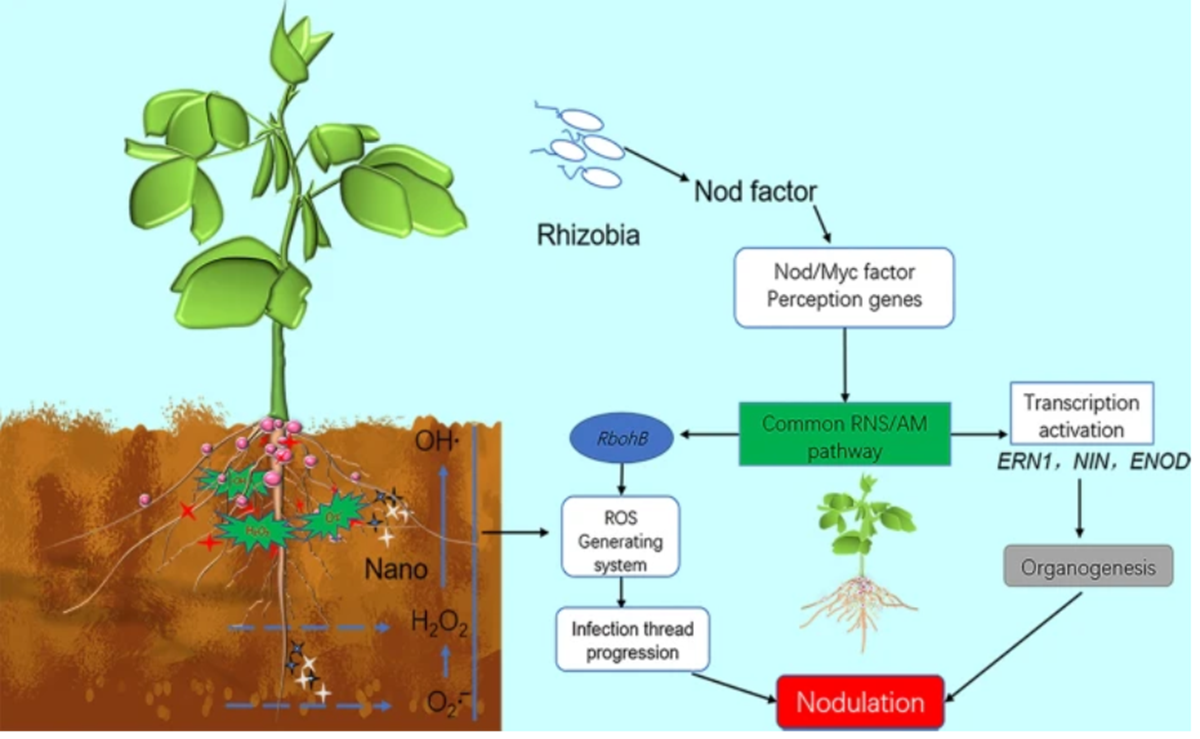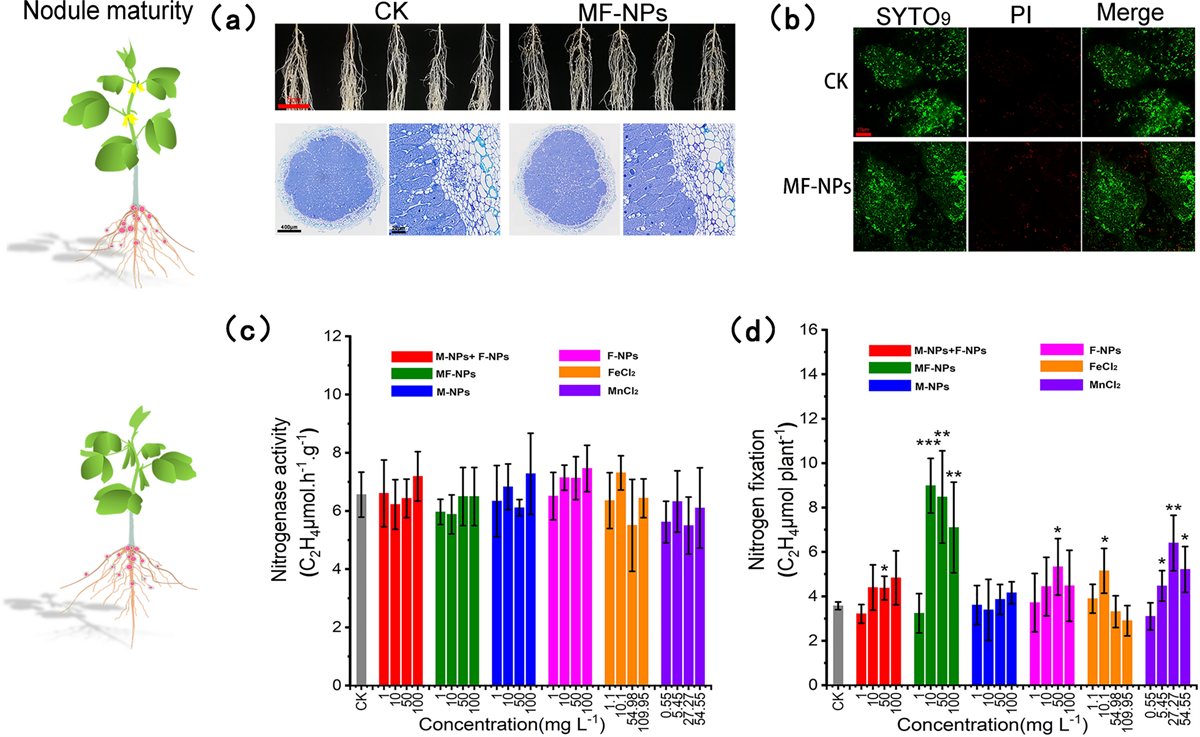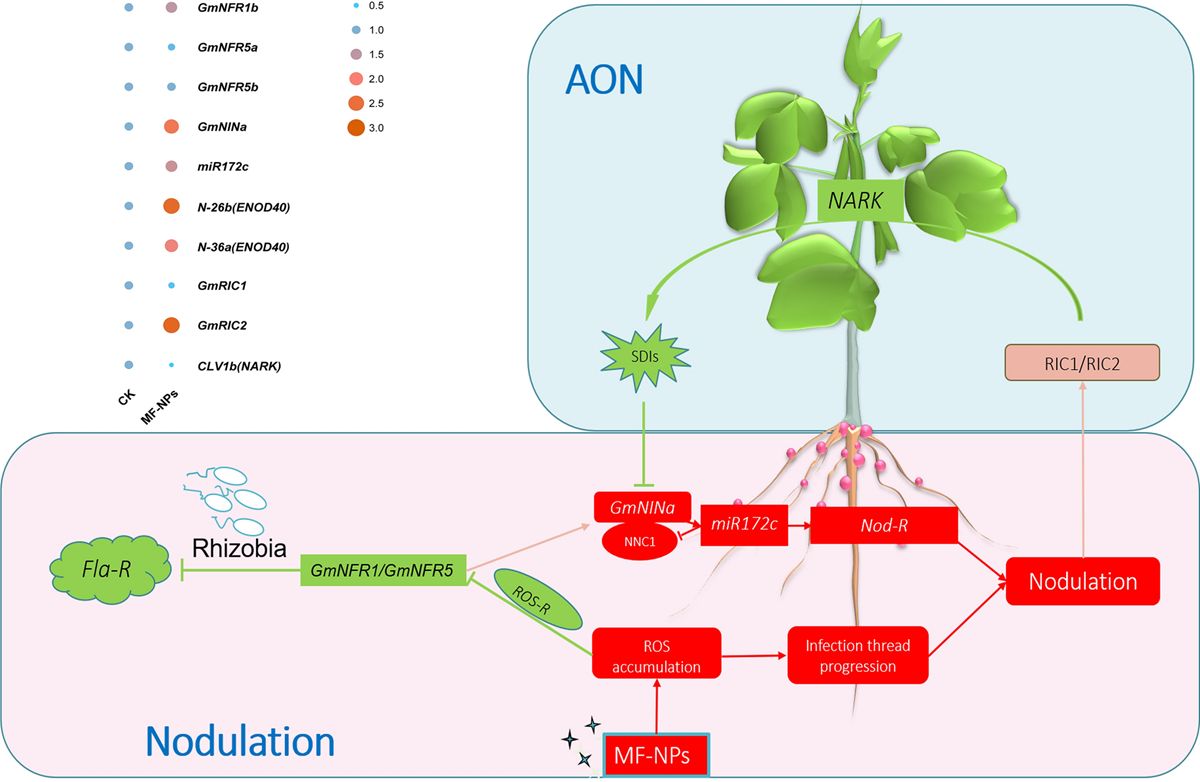南湖新闻网讯(通讯员 马骏)近日,我校理学院纳米化学生物学课题组在纳米酶调控活性氧增强大豆生物固氮研究方面取得新进展,相关成果以“Novel approach to enhance Bradyrhizobium diazoefficiens nodulation through continuous induction of ROS by manganese ferrite nanomaterials in soybean”为题发表在Journal of Nanobiotechnology上。
生物固氮为全球植物提供了75%的氮素。ROS过去一直被认为是植物代谢过程中的副产品,然而,越来越多的证据表明,ROS也是细胞信号转导和调控的重要组成部分。豆科植物中的ROS通过直接或间接作用诱导结瘤基因的表达,是根瘤形成以及固氮的重要信号分子。如何调控ROS水平,诱导豆科植物结瘤,从而延长结瘤时间,成为了生物固氮研究的新热点。纳米酶作为纳米技术与生物学之间的桥梁,为生物固氮研究提供了独特的解决方案。
如图1所示,韩鹤友教授团队根据大豆生物固氮酶的结构特点,研究设计了一种新型的锰铁纳米酶,构建纳米酶与大豆根瘤菌体系,通过持续调节ROS水平,延长结瘤期、增加根瘤数量,最终提高豆科植物共生固氮能力。

图1. 纳米酶调控ROS促进豆科植物结瘤
图2为纳米酶处理大豆植物后的实验结果:(1)根瘤重量和数量分别增加了 50.85% 和 61.4%,单株固氮效率增加了151.36%,生物量积累增加了25.70%;(2)转录组测序分析显示,在36个结瘤相关差异表达基因(DEGs)中,31个与大豆结瘤相关的DEGs在根瘤菌接种后期(12d)上调,表明纳米酶处理大豆根瘤后,诱导结瘤相关基因(Nod-R)表达从而促进结瘤的增加。

图2.不同浓度纳米酶处理对豆科植物根的表型和根瘤发育的影响

图3. 外源ROS调节结瘤和AON之间平衡的模型。
同时,为了评估纳米酶处理对结瘤自调控(AON)通路的影响,本研究分析了通路中相关基因的表达差异,包括 NFR1/NFR5(结瘤因子)、GmNINa(结瘤基因)、ENOD40s(结瘤反应基因)、NNC1(结瘤数量控制)、miR172c(微调根瘤菌感染和根瘤器官发生)、GmRIC1 和 GmRIC2(大豆中负责产生根源性结瘤的特定 CLAVATA/ESR 相关 (CLE) 肽)和 GmNARK(根瘤自动调节受体激酶)(图3)。结果表明:(1)纳米酶处理组和对照组之间结瘤因子(NFR1/5)的表达较低且无显着差异,这可能是外源ROS诱导的ROS表达基因下调导致的;(2)GmNINa、miR172c和ENOD40s均呈现上调趋势,阐明了结瘤数目增加的机制;(3)在AON通路中,NARK对GmRIC2和GmRIC1表达的显著上调没有明显反应,这可能是由于抑制了长距离运输的CLE肽。
综上所述,纳米酶处理可以通过延长结瘤期、增强结瘤基因的表达、增加结瘤数量,提高生物固氮能力,并且不影响植物的营养生长或触发结瘤的AON途径。 该研究为提高豆科植物共生固氮能力提供了新的策略。
博士研究生马骏为论文第一作者,宋智勇副教授和韩鹤友教授为通讯作者。该研究得到了国家自然科学基金和国家重点研发计划项目的资助。
审核人:宋智勇
【英文摘要】
Background
The study of symbiotic nitrogen fixation between (SNF) legumes and rhizobia has always been a hot frontier in scientific research. Nanotechnology provides a new strategy for biological nitrogen fixation research. However, how to construct abiotic nano-structure-biological system, using the special properties of nanomaterials, to realize the self-enhancement of biological nitrogen fixation capacity is important.
Results
In order to construct a more efficient SNF system, in this study, we applied manganese ferrite nanoparticles (MF-NPs) with sustainable diatomic catalysis to produce reactive oxygen species (ROS), thus regulating the nodulation pathway and increasing the number of nodules in soybean (Glycine max), eventually enhancing symbiotic nitrogen fixation. Symbiosis cultivation of MF-NPs and soybean plants resulted in 50.85% and 61.4% increase in nodule weight and number, respectively, thus inducing a 151.36% nitrogen fixation efficiency increase, finally leading to a 25.70% biomass accumulation increase despite no substantial effect on the nitrogenase activity per unit. Transcriptome sequencing analysis showed that of 36 differentially expressed genes (DEGs), 31 DEGs related to soybean nodulation were upregulated in late rhizobium inoculation stage (12 d), indicating that the increase of nodules was derived from nodule-related genes (Nod-R) continuous inductions by MF-NPs.
Conclusions
Our results indicated that the nodule number could be effectively increased by extending the nodulation period without threatening the vegetative growth of plants or triggering the autoregulation of nodulation (AON) pathway. This study provides an effective strategy for induction of super-conventional nodulation.
原文链接:https://jnanobiotechnology.biomedcentral.com/articles/10.1186/s12951-022-01372-2
